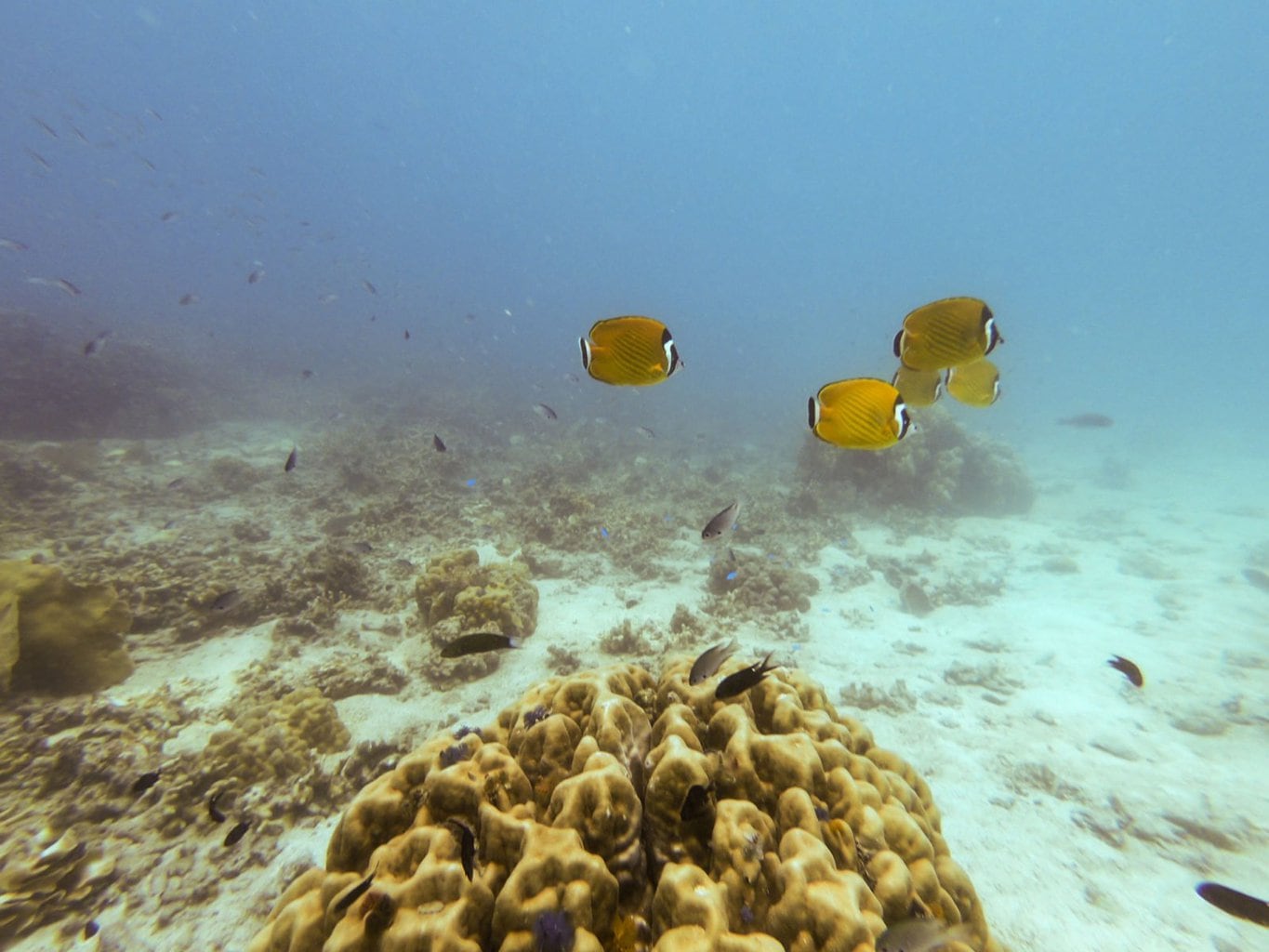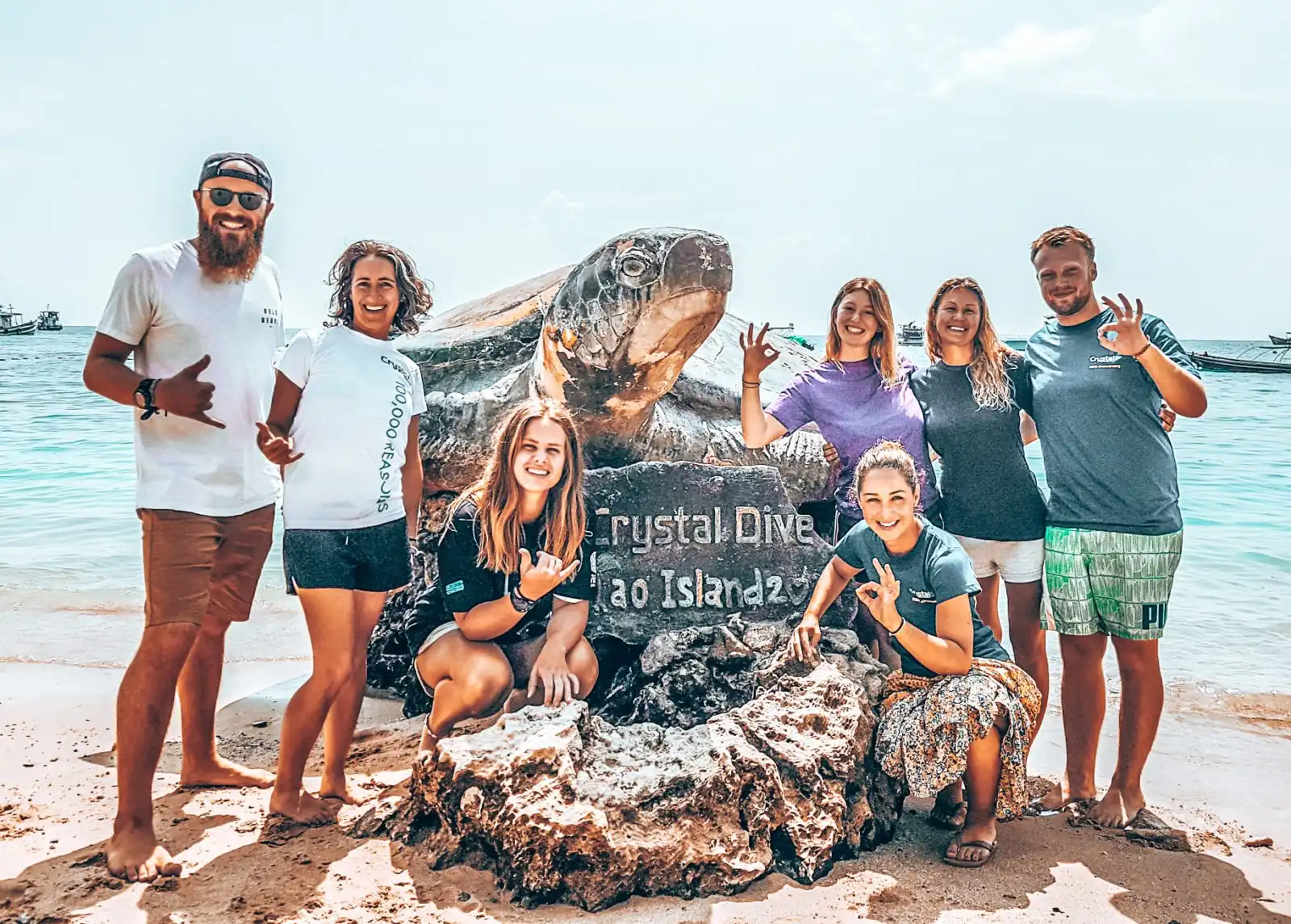We’re fresh off the boat. Or, more like, a fourteen hour train journey from Bangkok, Thailand. The train ride came with clanging metal bits (therefore we are really without sleep) and a questionable Western toilet. This was then followed by a high seas ‘drama’ which saw us moved from one ferry to another, in the middle of the ocean. But, we’ve made it to Turtle Island; we are going to learn to dive in Koh Tao, one of the best diving spots in Thailand.

Firstly, it is beautiful. Pad Thai stalls jostle with 7 Eleven stores for space, as bronzed, slightly salty-haired tourists zip through the streets on their mopeds. And the ‘World’s Best Pancake Stand’ does a roaring trade at all times of the day.
It’s scorching hot but we’ve landed in a diver’s paradise or, at least, the world’s most affordable place to learn to dive.
We’re here since I am keen to undertake my PADI Open Water and James his refresher (he hasn’t dived in 12 years). Since we’re on a backpacker budget, this is the place to do it. Thousands of wannabe divers flock to Koh Tao every year. Not only because it’s cheap as chips (approx. 500 pounds incl accommodation), but boasts fantastic conditions and is one of the best things to do in Koh Tao. Still, almost wave-less water in the Gulf of Thailand. Relatively good underwater visibility and thriving coral reefs. Granted, like many places around the world, much of the coral has been bleached or is recovering, but it’s still incredible to witness.
Skip ahead
Choosing your dive school
We picked Crystal Dive, the biggest and best resort on the island for Lee’s course. It was the right decision. Not only are Crystal the biggest, but they offer some of the most knowledgeable, experienced (and kind!) instructors. Not to mention the best facilities, their own huge dive boats and, most importantly, care deeply about the sustainability of the oceans and the impact of diving. They are huge supporters of Eco Koh Tao. A bid to ensure we respect the environment. They have even created their own dive site, the Junk Yard, by harvesting and tending to corals to build a new reef, now teeming with everything from whale sharks to parrot fish.
There are a plethora of dive shops on the island but many of them tend to use the boats of bigger outfits like Crystal, or might not have all the same facilities or the depth of experience.
Crystal also has their own accommodation, ranging from basic fan rooms to more upmarket air-conditioned rooms (which we took). This makes it very convenient to do your course with them although there are lots of fantastic hostels in Koh Tao that you could also choose from.
What does a PADI at Crystal consist of?
Day 1 – Theory, theory and more theory
We’re quickly checked into our room. We chose the air-conditioned rooms for 400 baht (10 pounds) extra a night. It’s worth the expense. And, after a really good night’s sleep, the PADI course starts with a day’s worth of theory. I’ll be honest – it’s not the most exciting of days. PADI likes you to watch endless reams of video footage, accompanied by eye-wateringly tedious ‘Knowledge Reviews’. So that’s all you can expect for Day 1. But, at least you’ll make some friends with those also bored to tears by all the theory.
Day 2 – Getting wet (and wild)
Day 2 is when it starts to get a little more serious. We’re stationed in the swimming pool for most of the day. We kick off with equipment reviews and then spending many hours in the chlorinated water. It’s about practising different dive skills, learning how to breathe (who knew that being a creepy mouth breather my whole life would pay off?!), and generally getting grandma hands and slightly sun burnt.
What’s great about the course is that you’ll spend so much time with your fellow students and instructors that you’ll have lunch, dinner and drinks with them. Today these friendships really starts to take shape. After all, you’ll pretty much entrust these people with your life when you’re underwater… So best you get on their good side!
A little aside here: today is usually when you do your PADI Swim Test. Essentially you need to showcase that you have some basic swimming skills, to ensure your safety in the ocean. This generally means a 200m swim and 10 minutes of keeping yourself afloat. I’m not the strongest swimmer so, if I’m honest, I was a little afraid of the test. And while I came last, it really wasn’t too much of a struggle.
Day 3 – Under the Sea

Today’s the day! You’ll do your first underwater dive and hopefully forget all your fears and just enjoy your 30-45 min submerged at the bottom of the sea.
But, first, your exam. Every prospective PADI Open Water diver must complete a test of 50 questions, of which you can get a maximum of 12 wrong. By this point you should easily pass the test. You’ve spent a day doing theory, a day practising that theory and, if you go with Crystal Dive, your instructors will have spent significant time making sure you understand all the key concepts and are primed for a pass.
After you pass (which you will, of course!), it’s a quick lunch break and onto your first official dive. Boarding the boat I’m filled with trepidation. Sunscreen? Check? Seasick tablets? Check. Game face? On!
Today we do two dives, mainly focused on testing our practical skills, like ‘hovering’, clearing your scuba mask and losing and then finding your regulator again. I’ll be honest – my first dive was tough. I had water pouring into my mask since I had chosen an ill-fitting one and I spent most of the time underwater just steeling myself not to panic and trying desperately to clear the stinging salt water out of my eyes. But, like any sport, it’s a steep learning curve and by the second dive I’m fitted with a new mask, the beautiful blue ocean is stretched out in front of me and I start to realise that this diving malarkey could just be for me. Just, whatever you do, DON’T press the red button!
Day 4 – Bitten by the diving bug
With two dives already done, the final day is really just to get more experience under your belt. You’ll do a few more exercises but generally it’s about enjoying your newfound freedom as a scuba diver. In our case, building human pyramids on the ocean floor and hamming it up for the videographer, Pedro, who has come out on the boat with us. You’ll float almost weightlessly as you saunter between bright purple and sizzling orange coral beds, flicking water at sea anemones and circling angel fish and manta rays as you explore a truly breath-taking world under the surface.
Finishing the open water was thrilling and brings a huge sense of achievement. In my case it was a triumph over my seasickness, mild fear of water and lack of coordination, all wrapped up in a aquamarine-coloured bow.

So, have you booked yet?
Learning to dive is an expense you will never regret. And, for most, if will bring hours if not years of enjoyment. You’ll gain a new appreciation for the ocean beyond simple snorkelling and watching David Attenborough documentaries, and you’ll join the club of people who can strap a tank of oxygen to their back and fall feet over head into the middle of the ocean.
What are you waiting for?! Head over to Koh Tao Thailand and get your water wings!
Some thank you’s!

While this wasn’t a sponsored trip, we still want to really thank a number of people for making it so special for us. To Nina and Nat, who kept James sane and cared deeply about our experience in Koh Tao. To Bo, the Dutch bodybuilder who loved diving and hating wearing his shirt (much to the delight of the ladies of the island, it seems). To Beard; he of the ice-cool blue eyes and equally cool attitude. To Mira, the Russian pocket rocket who doled out diving tips and hugs in equal measure. And to our newfound dive buddies: Isabella, Sophia, Felix, Fed, Jess and the imitable fellow South Africa, Kirsty (and Robbie).
if you’ve got any other queries on our dive experience on Koh Tao, contact us here!
Want to save it for later? Why not pin it…


